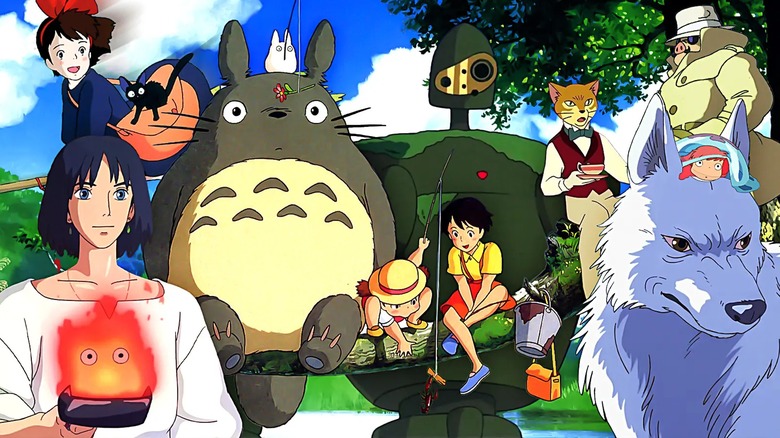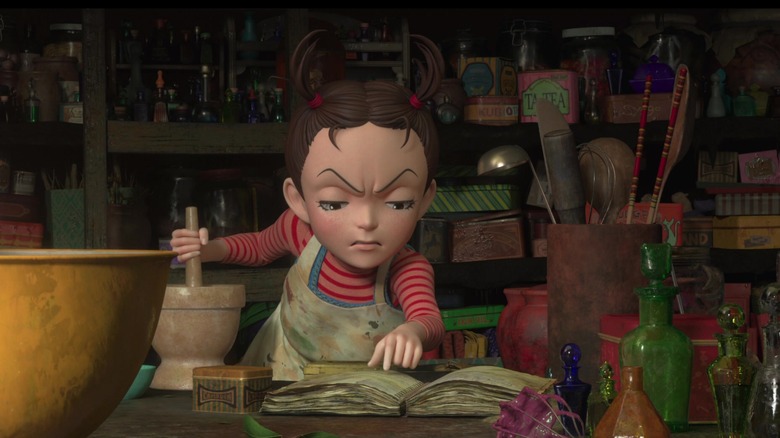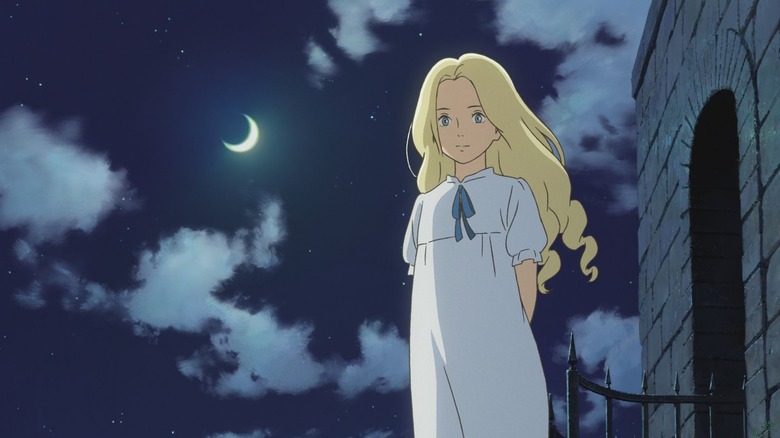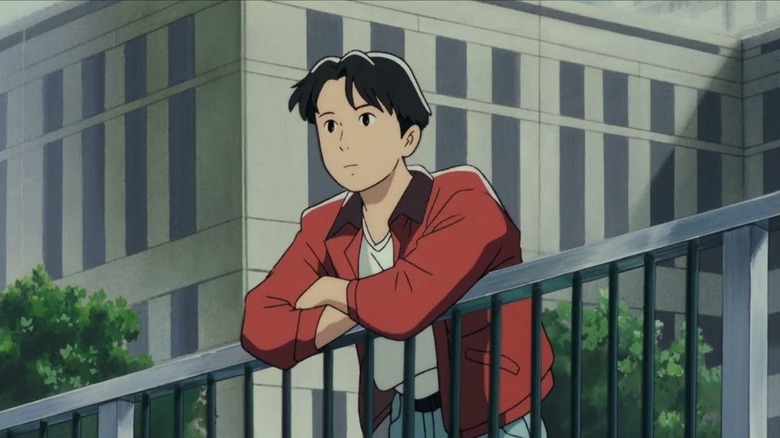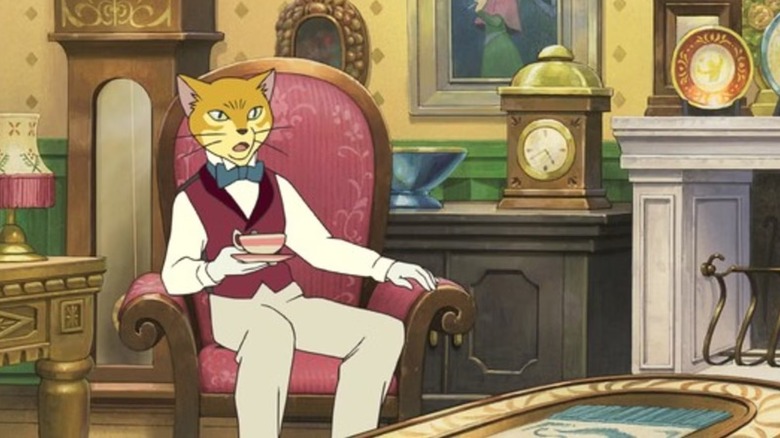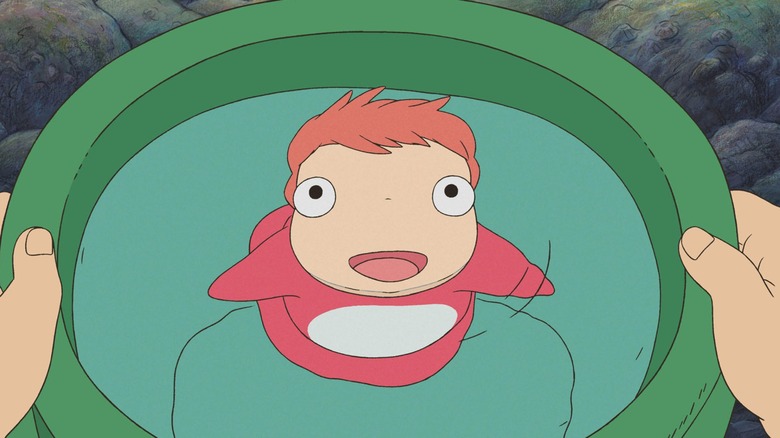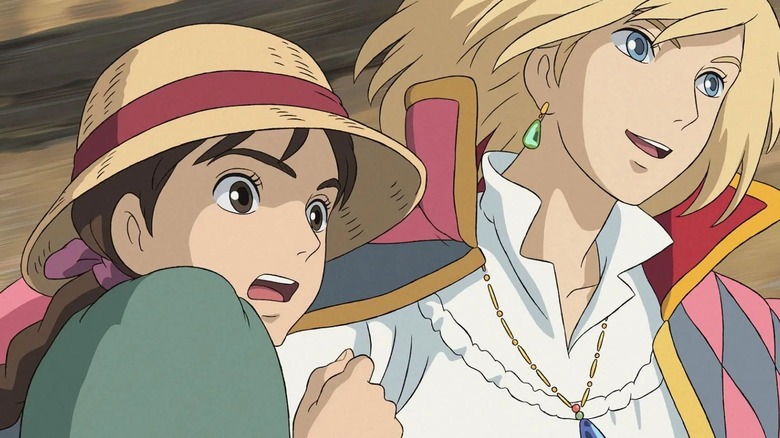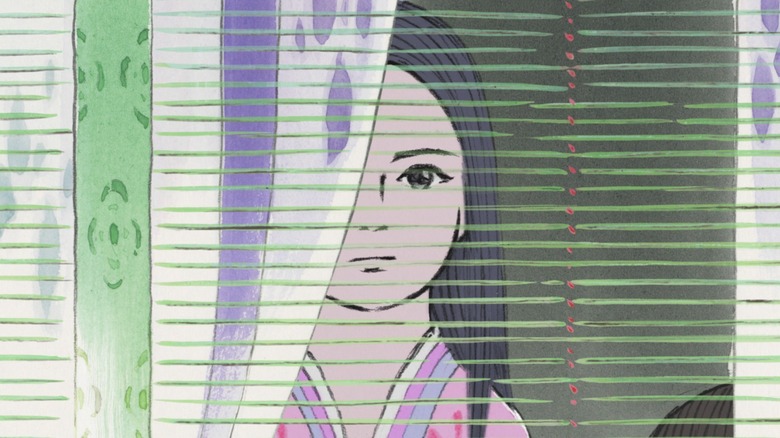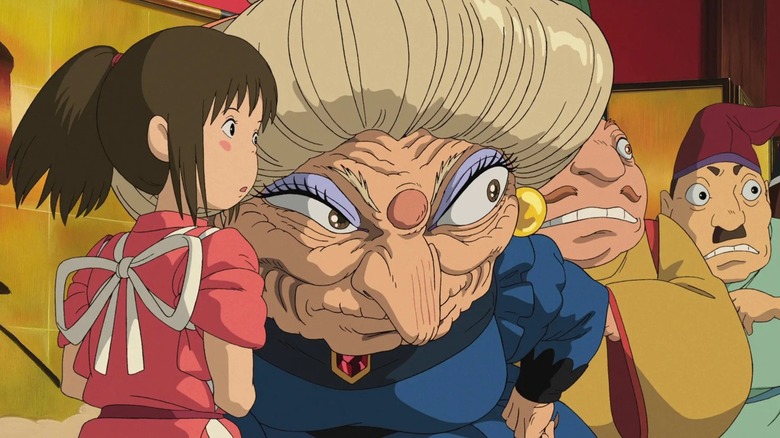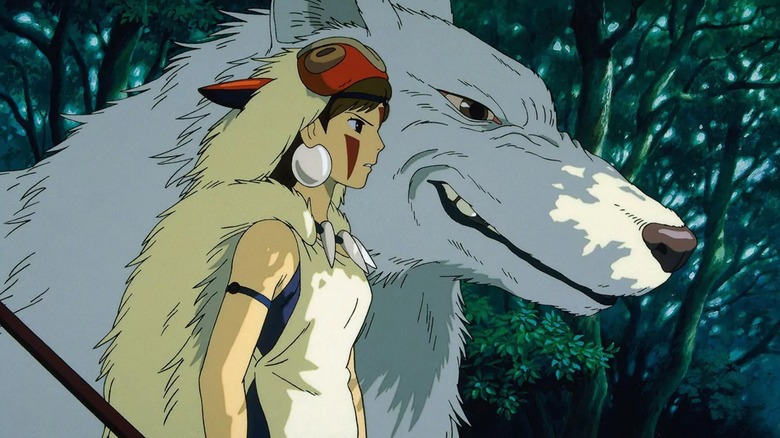All 24 Studio Ghibli Movies Ranked
Studio Ghibli was founded in 1985 by the already seasoned directors Hayao Miyazaki, who'd earned his bones at Toei, and Isao Takahata, who'd worked alongside him. With them was producer Toshio Suzuki, who, as Animage magazine editor, helped Miyazaki introduce "Nausicaa of the Valley of Wind" to Japanese manga fans. While the manga wouldn't be completed until 1994, Suzuki encouraged and assisted Miyazaki in completing the film, which led to the founding of Ghibli.
Of the 24 films Studio Ghibli has produced to date — including "Nausicaa," which may have been a Topcraft and Toei production but wouldn't exist without Ghibli's founders — few are a total failure. Even the controversial Goro Miyazaki films have gleams to them that might shine brighter if he didn't have his father's massive shadow over him. But nor can a list say that they're almost all number ones, because that's not fun to debate. These rankings are subjective but come from a lifetime of love for Ghibli's work. It's a love we hope you'll share with us.
24. Earwig and the Witch (2020)
Not to be confused with the tonally similar "Hedwig and the Angry Inch," Goro Miyazaki's third film is unfortunately not great. While the premise is cute — of course it is, this ferocious young witch child is born of another tale by "Howl's Moving Castle" writer Dianna Wynne Jones — the execution feels like a cheap "Miraculous Ladybug" knockoff. We apologize to French animators, but "Earwig and the Witch" is amazingly bad to look at.
Imagine the signature style of Studio Ghibli, with its magical storybook worlds and rounded characters full of emotion. Now sieve that through some cheap CGI program and turn it all into a 3D world so colorless and dead-looking that one might physically recoil at first glance. It really is that bad. Yet there is one credit in the film's favor. While the glam metal soundtrack clashes with whatever the hell is going on in this movie, it's still a really good soundtrack.
23. Tales from Earthsea (2010)
Sorry, Goro. Your first film venture, which sees science fiction legend Ursula K. Le Guin allowing one of her works to be animated for the first time, did not turn out well. Originally meant to have Hayao Miyazaki himself at the helm, Goro does his best to adapt a world by an author whose subtle yet stark understanding of the human experience requires others to approach her work with empathetic care. "Tales from Earthsea" manages to be better than the blitheringly whitewashed 2003 miniseries, but it still lands with a fumble.
Animated with a plainness that lacks Hayao's gift of living backgrounds and featuring a choppy story that places chunks of four different "Earths" books into one stew, the film does manage some neat bits. The fall of Lord Cob, the necromancer, is nicely chilling, and a good animated dragon is always a treat. Unfortunately, the results didn't please Le Guin, who'd taken a chance on Studio Ghibli's reputation and got the short straw in return.
22. Pom Poko (1994)
Studio Ghibli has more than one adorable animated film about humanity's connection to the spirits of nature, and this one is directed by Isao Takahata, not Hayao Miyazaki. Unfortunately, most Americans aren't mythologically prepared for the exuberant tanuki of "Pom Poko." There's no delicate Western way to put this: since the 1100s, Japanese legends have been enamored with the tanuki's magical gift of shapeshifting, and love to depict them with comically enlarged testicles. There's nothing sexual or even all that bizarre about this in context, but try explaining it to your friends while you're half-sloshed in an aggressively midwestern Dave & Busters.
Thus, "Pom Poko" really is a delightful, if somewhat on-the-nose ecological treatise. It's a great film for kids fascinated by nature and mythology, except for the whole tanuki-schnutz thing that, let's face it, is about to have a harder time than ever being handled rationally here in the West. It's a shame, but it's also the marker that says that all Ghibli films from here are terrific, if sometimes niche.
21. When Marnie Was There (2015)
Gothic dramas feel like they always begin with a sickly young woman sent to the seaside for her health, and it's a little surprising to watch that exact storyline begin to play out with that delightful Ghibli aesthetic. It's less surprising to learn that "When Marnie Was There" is, in fact, an adaptation of a beloved young readers novel by British author Joan G. Robinson, and the fantastical gothic feeling is pinpoint accurate.
Anne is an asthmatic young girl sent to the Japanese seaside to strengthen her lungs, but it's not her health that troubles her. It's her feeling of being unanchored, frightened of secretly being unwanted by her adoptive parents. With the help of the mysterious Marnie, who lives, naturally, in an abandoned mansion, Anne eventually finds her place in the world. It's a slow film and one of the lesser-known Ghibli projects, yet there's still a beauty to it worth discovering.
20. From Up on Poppy Hill (2011)
Goro Miyazaki finally earned a win with a nostalgic and sweetly respectful film about the comfort that can be found in tradition. "From Up on Poppy Hill" is a '60s period piece, and just like here in America, that era was a turning point for young students increasingly aware of the pain and injustice doled out by war. The crux for these youths isn't directly the 1964 Tokyo Olympics, which does offer an international backdrop that keeps this post-war period in the foreground, but the threat to a favorite campus building.
As all this is going on, Umi Matsuzaki honors her late father with a simple ritual every morning: She raises a set of maritime flags to pray for the safe return of sailors. Caught up in the effort to save the old clubhouse and her mixed feelings for a boy she meets thanks to that ritual, Umi's story isn't convoluted so much as an example of how beautifully tangled our lives can be. Though the screenplay is by Hayao Miyzaki, Goro, perhaps understanding what it's like to lose a father to some faraway sea, makes the film's details shine.
19. Ocean Waves (1993)
One of the many refreshing things about Ghibli films is that they never shy away from the depth necessary to explore the stories of women and girls. The possibly secretly queer "Ocean Waves," better known as "I Can Still Hear The Sea" to those of us who watched the bootleg in the mid-'90s, isn't quite josei — manga and anime for older women — but it's some of the most emotionally mature shoujo you'll have the honor to experience. It treats its high school-era love triangle with rational ups and downs and relatable family complications; that's already enough of a rare treat.
The only drawback to this sometimes raucous investigation of mixed-up young love is that there's little of the spirituality or dreamlike wistfulness to be found in Ghibli films. The closest this film comes is the soft romance of the titular ocean waves. All of that is part of why Disney never released this one here as part of its peace with Ghibli. It took until 2016, when GKIDS distributed it without an English dub, keeping it in a niche.
18. My Neighbors the Yamadas (1999)
The "yonkoma" or 4koma comic strip manga is often used as those little gag pages you'll find at the back of a volume of "Full Metal Alchemist," or used for video game manuals. It's still far more popular in Japan than in North America, and Isao Takahata's "My Neighbors the Yamadas" leans fully into this scratchy newspaper cartoon style to set up quick, adorably mundane glimpses into the lives of the Yamada family.
The pen and pastel art and rapid-fire self-enclosed stories that almost always come back to the way a family's love for one another will forever come through make this film a weird entry to the Ghibli canon. It's another one Disney didn't know what to do with, although a dubbed release did sneak out in 2005. Don't worry if you missed it then; much like "Ocean Waves" it took GKIDS to give it a bigger Blu-ray release over a decade later.
17. The Cat Returns (2002)
Studio Ghibli has never made a traditional sequel to one of their films, and although "The Cat Returns" wouldn't exist without "Whisper of the Heart," it's still no mere follow-up. The Baron, once a fiction inspired by a statuette, is back and full of life. The chonky stray cat, Muta, also earns a Kingpin-style backstory during shy Haru's adventure through the Cat's Kingdom, where her lack of confidence in herself not only sets her up in an arranged royal marriage but is literally turning her into a feral cat.
As we said, Ghibli is always eager to show girls learning to empower themselves to become stronger young women, and "The Cat Returns" does a pretty good job at making Haru's journey something special. Emotionally, it's not as strong as its inspiration, and a jumbled plot heavily weakens the film. Still, it's a good time for cat lovers who couldn't get enough of the Baron last time. Dub fans, double down on the joy: The Baron is voiced by our beloved Westley himself, Cary Elwes.
16. Only Yesterday (1991)
The "Before Sunrise" series of films from director Richard Linklater is a romantic, emotional, and unusually realistic set of journeys through a meet-cute that becomes a lifetime. There's nothing else quite like it, except, perhaps, "Only Yesterday," which was released four years earlier than the surprise Julie Delpy and Ethan Hawke blockbuster. The biggest difference is that viewers experience that couple's emotions as observers. Director Isao Takahata takes us into the mind of Taeko, an almost-thirtysomething woman whose busy life has distracted her from a childhood life full of memories that might yet enrich her today.
The romance that gradually comes Taeko's way is as simple and elegant as Ghibli's depiction of rural Japanese life. Toshio also left the city for the fields and stayed. In his brisk but kind attitude, Taeko eventually sees a glimpse of what she really wants for herself. "Only Yesterday" is a brilliant film, and another Disney ignored during their distribution of Ghibli films in the '00s. It finally received a wide U.S. release in 2016.
15. Ponyo (2008)
"Ponyo" is a gateway drug, a perfect film for young children who may still find Totoro scary or have trouble with the understated story. Inspired by familiar fables like "The Little Mermaid," little goldfish baby Ponyo is instantly relatable and adorably squishy, even as she too begins to become human. It allows for a gentle return to Hayao Miyazaki's common themes of environmentalism and balance, as Ponyo's desire to live beyond the sea unsettles more than her royal family and their wizard patriarch. Their goddess mother must bring home the news that the moon itself may fall out of orbit, all because of her child's wish.
Older Ghibli fans will still fall in love with the animation, which is some of the studio's very best. Though Miyazaki has made some peace with the tools available via CGI, "Ponyo" is classically animated. That makes this film a gift for any age, with a happy ending that feels not only well-earned but still just as magical as everything that came before.
14. Whisper of the Heart (1995)
One does not go to Japanese cinema and expect John Denver, but that's just one more surprise Studio Ghibli has to offer. Denver's classic song "Take Me Home, Country Roads" isn't some one-off thing; here, it's the film's leitmotif. Riffed on by our young heroine, Shizuku, it becomes a lyrical red string between her and the would-be instrument crafter Seiji. As Seiji chases an opportunity to grow his skills, Shizuki doubles down (then triples, to the far point of obsession) on her dream to be a writer. Thus she begins the story of the Baron, the clever cat that will later helm his own tale in "The Cat Returns."
Shizuku's tale, offered in brief but fantastical snippets, isn't the focus, so the Baron's story feels disjointed and perhaps too simple. But it's also heartfelt, a child's intensely passionate early work. With the help of Seiji's grandfather, realizing that is the key to Shizuku's next phase of life. In all, this is one of Ghibli's most sincere films.
13. The Secret World of Arrietty (2010)
Another adaptation of a British classic, "Arrietty" is better known to the English as "The Borrowers." Featuring a clan of itty bitty people living a secret life within the walls of the homes we hulking critters live in, tiny lass Arrietty eventually forges a friendship with a sick young boy named Sho. Fans of "The Secret of NIMH" will find a few interesting parallels here, from skeptical adults all too happy to ruin the magic of these small and secretive lives to straight-up calling exterminators to get rid of the little bastards.
Sho, meanwhile, learns courage from Arrietty, which helps him to prepare himself for the very possibly fatal surgery he needs. His friendship with the clan of borrowers is all too brief, of course, as Arrietty's family has to pack up and leave if they wish to survive. This is a pleasant, often special film about lives that are both ordinary and magical.
12. The Wind Rises (2013)
Similar to Hideo Kojima, Hayao Miyazaki's strongest feelings come with a paradox. Also a pacifist, Kojima slides both subtle and unsubtle anti-war sentiment into his work, while Miyazaki can't help but love the elegance of a machine turned into a tool of war. The poetic beauty of flight features in much of his work, with "The Wind Rises" an exploration of the paradox itself.
Thinly based on engineer Jiro Horikoshi, "The Wind Rises" follows his dream — sometimes a literal dream — of creating a beautiful flying craft. It's a bitter irony that to do so sees Jiro survive the Great Depression with the help of a job at Mitsubishi, where he works to improve the jets that will eventually feature in World War II. Jiro's masterpiece becomes the A6M 'Zero,' a cutting-edge fighter that would join the attack on Pearl Harbor. The pain and beauty continue to parallel for Horikoshi, as even his life with his beloved Nahoko cannot end in simple happiness. No celebration of war, it's a gentle whisper that the tools we make are just so, and it is our humanity that guides our hands when wielding them.
11. Porco Rosso (1992)
Thematically entwined with "The Wind Rises," but with a vibrant edge, "Porco Rosso" is about a rogue flying ace who carries with him an intriguing curse: his head is that of a swine. But it's the roaring Twenties, World War I has just ended, and this pig kills fascists. That's already rad as hell for a Studio Ghibli movie, but "Porco Rosso" adds on the full "Casablanca" as Porco and the lovely hotel manager Gina refuse to just spit it all out until near the very end — and even then, they're merely implied to have earned their happy ending at last.
Featuring some of the coolest animated dogfights in history while this hero pig repeatedly dunks on Benito Mussolini's Air Force, this film also another love letter to Miyazaki's obsession with avionics. Porco's Italian planes are lovingly rendered — if fictionalized. Most are inspired by the planes of Macchi Aeronautica and designer Mario Castoldi. All of it is gorgeous and ever timely.
10. Castle in the Sky (1986)
Studio Ghibli's first official release contains a little bit of everything that director Hayao Miyazaki continues to love, from a variety of flying machines to unmistakable anti-war warnings. Sheeta is the last princess of Laputa, a kingdom hidden among the clouds. Her escape lands her practically in the lap of Pazu, a nice but impoverished kid working hard labor in a rural Victorian-era land. Chasing them is a secretive but incredibly jerky government agent named Muska, who wants the lost technology of Laputa for his own dark purposes.
"Castle in the Sky" is thusly a terrific crib sheet for assessing whether or not you'll be a fan of further Ghibli works. Visually quite old but still vibrant, it's a wonderful film with fresh, imaginative bits. It's hard to not feel something when Sheeta and Pazu explore Laputa's lost gardens, nor will you not love the aggressive, matronly Dola and her air pirate gang.
9. Howl's Moving Castle (2004)
Also adapted from a novel by English author Diana Wynne Jones, "Howl's Moving Castle" is arguably Hayao Miyazaki's most underrated masterpiece. The movie clips out some of the weirdest and most fascinating bits of Howl's backstory — he's a playboy tax dodger from actual Wales who also happens to be an infamous wizard in the fantastical kingdom of Ingary — but still gives us plenty to adore in its titular character. That the dub features Christian Bale as this vain and charismatic coward is a bonus, but we assure you, you'd love Howl anyway.
Sophie, meanwhile, is no simple cursed damsel in distress. A crabby witch may have aged her into a "Golden Girls" guest star, but Sophie is determined to fix the problem herself. Well, mostly herself. Along the way, she creates one of the finest romantic fantasies to ever exist, out of a beautiful riot of colorful magic and earnest emotion — and Miyazaki's ever-pointed opinions about war. By this point in the list, every film is a must-watch. Do it for Calcifer.
8. Kiki's Delivery Service (1989)
If you're having a bad day, a mini movie marathon of "Kiki's Delivery Service" and the next film on our list will help perk you up. Kiki is a young witch with her black cat familiar, Jiji, at her side when she goes out into the world to seek her own place in it. She settles in a bucolic, European-style village, and despite how quickly she fits in, poor Kiki suffers a pretty serious self-confidence crisis, cramping her powers so thoroughly that she can't even talk to her cat. And he's off, well, tomcatting with a pretty little thing up the street.
It's far from depressing, however. Kiki's rocky road comes with friends that understand what she's going through, if not from a magical perspective. But empathy can be magical enough, and it gets her victoriously back on her broom before it's all said and done. Not only one of Ghibli's greats, this movie can be a salve for young girls going through a similar pile of emotions.
7. My Neighbor Totoro
"My Neighbor Totoro" is the apex of 'It's just a nice movie." There's a definite theme of hope and whimsy to cling to, as the rural fantasy of these fuzzy trolls and their catbus transport is key to helping Satsuki and Mei bear the stress of their sick mother. It's also about our connection to nature, and how the health of the world around us can be reflected within us. The children play with Totoro and help grow trees, marking their own growth, and much of this wilderness echoes their fears and comforts as they visit their mom.
It's a peaceful, quietly spiritual movie, and it's a terrific place to introduce kids to the magic of animation. Although certain traditions in the film, like family bathing and the father's casual acceptance of his kids' belief in Totoro as a forest spirit, are normal to Japan and will prompt some questions elsewhere, it's all harmless and wholesome. For many fans, this one's a secret favorite.
6. Nausicaa of the Valley of Wind (1984)
It may nominally be pre-Ghibli because Topcraft produced it, but "Nausicaa of the Valley of Wind" is Hayao Miyazaki's baby, and it set the stage for decades of Studio Ghibli anime. It is also accepted as fact that Nausicaa's first trip to the United States was a disaster, as a horrifically chopped dub called "Warriors of the Wind" meant the eventual localization of "Princess Mononoke" came with a weaponized warning to not edit that film in any way.
"Nausicaa" is adapted from Miyazaki's own manga, which had not yet wrapped when the film was made. As such, it's only a portion of the full saga. Not that it detracts at all from Nausicaa's journey to halt the wars still encouraged by a long-ago age of apocalypse. It's Ghibli's "Dune," a saga of a reluctant messiah whose role in prophecy is not quite what anyone expected. "Evangelion" creator Hideaki Anno was a key animator on this film, and the terrifying God Warriors clearly left an impression on him, as he would later also commission the short film "Giant God Warrior Appears in Tokyo."
5. The Tale of the Princess Kaguya (2013)
Not all Ghibli films are happy and uplifting, as the lady Kaguya will be honored to remind you. Isao Takahata's heartbreaking last work is an adaptation of a Japanese fable, an elegant embrace of humanity, grief, and loss. Kaguya's entire life is bound by the restrictions of others, from the well-meaning rural bamboo cutter who finds her as a child inside a shoot, to a privileged life as a noblewoman. All she wants is to be human and to live her life as a free woman, and it's the ultimate tragedy to discover that she'd even given up celestial immortality for this chance. All that did for her was teach her mortal pain, as all these "privileges" kept her from the simplicity she wanted back in her first rural village.
Painted in watercolors where every thin line and every color choice has meaning, "Kaguya" is one of Ghibli's hardest watches for its soul-crushing story. No joke intended, "Kaguya" is what "Barbie" would be if it was one of the most sorrowful movies ever made.
4. Spirited Away (2001)
It's occasionally too scary for very young viewers — Chihiro's parents getting turned into screaming, squealing pigs seems to hit a lot of little kids like a brick, to say nothing of the giant baby head lurking around the witch's apartment. But "Spirited Away" is still a winner if you're confident in your children. At 10 years old, Chihiro herself may be too young for some of what's going on around her, but dangit, she's going to brave this yokai bathhouse and get her family back anyway.
Watching her back is the older-sister-coded Lin, the initially polite No-Face spirit, and Haku, the mysterious boy locked into the witch Yubaba's service. Haku, in particular, has his fate entwined with Chihiro's, as he too is a spirit, and only she might remember his real name. Within all of this is a fable about growing up. But maybe not too fast, and not without remembering the power of the spirits all around us.
3. The Boy and the Heron (2023)
Ghibli fans make jokes about the revolving door of Hayao Miyazaki's retirement, but they're affectionate jokes followed up by the fact that he always returns with a banger of a flick. "The Boy and the Heron" is inspired by the themes (but not the plot) of a Japanese novel called "How Do You Live?" It's that question that moves young Mahito, a boy in a rocky frame of mind after his mother dies, and for a long while, his answer is found in a restless sense of violence.
His nemesis is his own grief and anger, which is keeping him from finding peace with his aunt, who's now his stepmother. But it also takes the shape of a gray heron with, if you watch the dub, Robert Pattinson jamming out one of the garnliest voice acting jobs in modern history. It's an incredibly strong film about the difficulties of being a young boy in a world without clear answers, and one of Miyazaki's most personal.
2. Princess Mononoke (1997)
Taut, violent, and bittersweet, "Princess Mononoke" is also worth every laurel for reintroducing Studio Ghibli, properly this time, to American audiences. Dubbed and distributed through Disney's Miramax label, it didn't set the U.S. box office on fire. But even if the narrative is complicated by its violence and maturity – somehow, Americans still have trouble understanding that animation does not guarantee that a film is safe for kids – it nonetheless revitalized the awareness of Studio Ghibli among movie aficionados and hipper geek crowds.
In a sense, "Mononoke" is a matured version of "Nausicaa," containing many of the same themes It's also about trying to save the spiritual world when the ecological world is thrown fatally out of balance. Yet it does this without making Lady Eboshi's steel town survivors (and god-hunters) into simple villains. There's a complicated, mythic thread winding throughout this film, and it unravels its secrets a little more every time you watch it.
1. Grave of the Fireflies (1988)
Director Isao Takahata is not as well known or beloved as Hayao Miyazaki, possibly because his subjects often feel more real, and rarely shy away from heartbreak. His magnum opus is "Grave of the Fireflies," grimly worshipped as a film you will watch only once — it could be Studio Ghibli's saddest movie ever. It's not the easiest way to sell such a project, but it is the most truthful, and the film is unmissable.
Based on the Kobe firebombing of 1945, it's not difficult to understand why it gets jumbled up as a film about the nuclear bombings of Hiroshima and Nagasaki. The result is functionally the same, where more than towns are ruined. Families and social traditions are put to the torch, and kindness is a privilege few can afford. Written semi-autobiographically by a survivor, it's a lament about what it costs to survive when the answer is everything. In the end, and this heartbreak is clear at the beginning, pride and desperation bring death to two children. It's not clear how anything could have been different. Sometimes the world is horrifically unfair, fed by the violence we give to it. Come and see.
